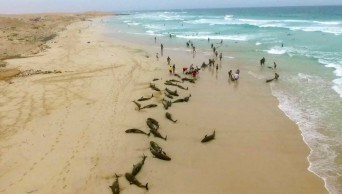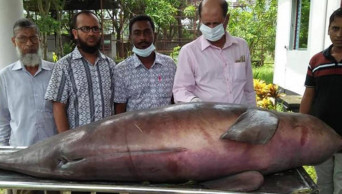dolphins
Neglect endangering red-listed dolphins in Halda River
The endangered Ganges river dolphin is one of two distinct dolphins living in the rivers of South Asia. It lives in the Ganges and related rivers of South Asia, namely in the countries of India, Nepal, and Bangladesh.
The Ganges river dolphin’s range lies within some of the Earth’s most densely populated areas. Typically, both fishermen and dolphins congregate in the same spots where nutrients are rich, currents slower, and fish concentrated.
Because of this intersection, Ganges river dolphins are mainly threatened by human activities such as pollution, bycatch, and infrastructure, but also suffer similar consequences of climate change as other marine mammals.
Although the Halda River in Chattogram was declared as Bangabandhu Fisheries Heritage in 2020, it has gradually become more dangerous for these freshwater mammals.
The Ganges dolphins locally known as Utom or Shushuk like to live in clean water. But Halda's aquatic environment is becoming increasingly unsafe for dolphins due to water pollution, which experts say is a gloomy sign for the environment and Halda as well.
The Ganges dolphin was red-listed by the International Union for Conservation of Nature (IUCN) as an endangered species in the country.
Read more: Another dead dolphin recovered from Halda River
According to experts, there are only 1,100 of these dolphins in the rivers across the world. Among them, there are 170 in Halda alone.
Unfortunately, 39 dolphins are documented to have died in the Halda in the last four years, including 6 in 2022. Of these, three dead dolphins were recovered within a span of just one week in July.
The last dolphin carcass (39th) was recovered from the Halda River in Hathazari upazila of Chattogram district on November 3, 2022. The cause of the dolphin's death could not be known as the carcass was found decomposed. These aquatic animals are dying one after another but no one cares.
Dr. Md Shafiqul Islam, a researcher on the Halda River, said fishing is being done illegally in various parts of the river using different types of nets, spears and poison.
Besides, food scarcity, pollution, poor water quality and climate change are behind the deaths of dolphins. Lack of awareness about the existing laws among the people, indifference on the part of authorities concerned have made water pollution a negligible crime - even though its effects on the environment can be severe.
The authorities concerned as well as everyone involved in Halda must work together to make the Halda a safe habitat for dolphins, added Dr. Shafiqul.
According to Halda River Research Laboratory, the local administration has recovered 39 carcasses of dolphins from the Halda River since September 2017 and most of the carcasses bore several injury marks.
Read more: Halda fish egg collectors brood on misfortune
A research report on the biodiversity and pollution of the two banks of the Karnaphuli River, led by Omar Faruq Russell, associate professor of the Botany Department of Chittagong University, was published in October 2022.
According to the report, Shikalbaha and Boalkhali are the two points of the Karnaphuli River where dolphins are usually sighted due to the fewer water vessels. It also mentioned that dolphins are under constant threat due to pollution.
Manjurul Kibria, river researcher and chairman of the zoology department of Chittagong University, told UNB that the rate at which dolphins are dying in the Halda River is alarming. Effective steps should be taken now to protect the Halda dolphins immediately. Otherwise, it won't take long for the number of dolphins in Halda to drop to zero.
“In 2018, we found the presence of 167 dolphins in Halda. In 2020, that number decreased to 127. In 2022, the number again rose to 147, which is the highest in the rivers of Bangladesh,” he added.
Nets are the main cause of death of these dolphins as most of them died after being caught in the nets of poachers, the researcher observed.
When asked about this, Hathazari Upazila Executive Officer (UNO) Muhammad Shahidul Alam told UNB that they are working regularly to protect the dolphins and biodiversity of Halda River.
New action plans are being taken to protect the dolphins, he added. In 2019, the High Court formed a committee to protect Halda river dolphins comprising Chattogram District Commissioner and Chittagong Divisional Forest Officer (Wildlife and Nature Conservation Department) as Member Secretary.
Read more: Miscreants kill dolphin in Halda River
According to the instructions of the High Court, the responsibility of protecting these dolphins goes to the Forest Department. But they have no headache in this regard.
Locals complained that they did not get any rescue support from the Forest Department upon the death of any dolphin.
In this regard, Chittagong Divisional Forest Officer (Wildlife and Nature Conservation Department) Md. Rafiq said dolphins are dying due to geographical changes. "We are taking necessary measures upon the news of any dolphin's death," he said.
Mohammad Mominur Rahman, district commissioner of Chattogram said, "We have stopped all sources that pollute Halda, and 17 industrial plants along the Halda river have already been shut. And the waste from the remaining industries is not allowed into the river.”
He also said that the district administration is doing everything necessary to protect the Halda River.
“We have brought the important part of Halda River under CCTV camera. Not only that, we have closed 9 brick kilns adjacent to the river. Motorboats have been completely banned. But we are yet to identify the reason behind the death of dolphins in Halda,” he sighed.
3 years ago
US bans swimming with Hawaii's nocturnal spinner dolphins
U.S. regulators on Tuesday banned swimming with Hawaii's spinner dolphins to protect the nocturnal animals from people seeking close encounters with the playful species.
Swimming with dolphins is a popular tourist activity in Hawaii. Several companies offer tours that take swimmers to areas frequented by dolphins with the aim of giving them an opportunity to get in the water with the animals.
Read: Govt 'working hard' to save dolphins
The National Oceanic and Atmospheric Administration rule under the Marine Mammal Protection Act prohibits swimming with or getting within 50 yards (46 meters) of a spinner dolphin that is within 2 nautical miles (4 kilometers) of the shore of the main Hawaiian Islands. The rule applies to boats, canoes, stand-up paddleboards, drones or other objects.
NOAA also is proposing a regulation that would prohibit entering certain areas between 6 a.m. and 3 p.m. in parts of the Big Island and Maui that are considered essential daytime habitats for spinner dolphins.
Read: Three more dolphin carcasses found off Chattogram coast
Spinner dolphins hunt in offshore waters at night. During the day, they use areas close to shore that have optimal environmental conditions to socialize, nurture their young, hide from predators and rest in preparation for nightly hunting.
Hawaii’s spinner dolphins get their name from their habit of leaping in the air and spinning around. Some scientists say such behavior is not always playfulness and can instead be an attempt to alert others to danger.
4 years ago
Govt 'working hard' to save dolphins
The Bangladesh government has said that it is taking all necessary steps to protect river dolphins and reverse the decline of these amazing cetaceans.
5 years ago
Dolphin found dead in Halda River
A dead dolphin was found in Halda River of Chattogram on Tuesday night.
5 years ago
More than 100 dolphins die on island beach off West Africa
Lisbon, Sep 27 (AP/UNB) — Authorities in the Cape Verde islands off West Africa are waiting for experts from Spain to help determine why more than 100 dolphins died on a local beach.
6 years ago
The disappearing dolphins of Sundarbans
Khulna, Aug 10 (UNB) – The Sundarbans, the world’s largest mangrove forest known for its unique flora and fauna, is home to some globally endangered species, including the Royal Bengal Tiger and freshwater Ganges and Irrawaddy dolphins.
6 years ago











